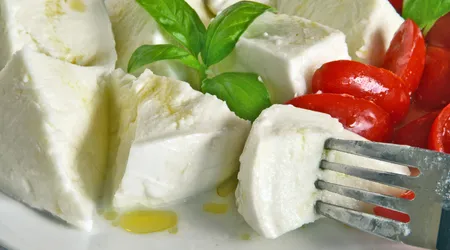Buffalo mozzarella from Campania: differences from classic mozzarella

Buffalo mozzarella from Campania, a symbol of Italian gastronomic tradition, enchants palates all over the world with its soft texture and rich flavor.
Announcements
This fresh, stretched-curd cheese, made exclusively from Mediterranean buffalo milk, is clearly different from classic mozzarella, often called fior di latte, which is made with cow's milk.
But what are the peculiarities that make the buffalo mozzarella from Campania an unmatched product?
In this article, we'll explore the organoleptic, nutritional, and cultural differences between these two dairy treasures, delving into their histories, production methods, and their role in Italian cuisine.
With a particular focus on artisanal techniques, PDO regulations, and 2025 trends, we will offer a sensory and informative journey, enriched with practical examples and up-to-date data.
Announcements
Get ready to find out why the buffalo mozzarella from Campania it's not just a cheese, but an experience.
Imagine sinking your teeth into a shiny white sphere, releasing an explosion of fresh milk, with a perfect balance of sweetness and saltiness.
This is what makes the buffalo mozzarella from Campania Unique. It's not just about taste, but a deep connection with the Campania region, the provinces of Caserta and Salerno, and other select areas of Central and Southern Italy.
Classic mozzarella, on the other hand, while versatile and popular, has a more neutral profile, ideal for everyday dishes.
Through a detailed analysis, we will guide you through the nuances that separate these two products, with a look at recent innovations and consumer preferences.
Why choose one over the other? Read on to find out.
Origins and Tradition: A Cultural Heritage
There buffalo mozzarella from Campania Its roots date back thousands of years. It is said that buffalo arrived in Italy with the Normans around the year 1000, although some fossil finds suggest indigenous origins.
Their presence in the Campania marshes has given rise to a unique cheese, codified in 1996 with the Protected Designation of Origin (PDO).
Classic mozzarella, on the other hand, comes from peasant tradition, with cow's milk easily available throughout the country.
Think of a summer caprese: the buffalo mozzarella from Campania elevates the dish to a level of sophistication, while the fior di latte offers simplicity.
Buffaloes, raised on pasture in humid environments, produce a rare and precious milk, about 8 liters a day compared to the 30 of a cow.
This makes the buffalo mozzarella from Campania a niche product, celebrated at events such as the Bufala Fest in Naples.
++ Type 00, Manitoba, and Semolina Flour: Which One to Use and When
The more widespread classic mozzarella is suitable for industrial production, but lacks the local connection that makes the PDO an icon. In 2025, the Protection Consortium continues to promote traceability, guaranteeing authenticity.
A practical example? At the Vannulo dairy in Capaccio Paestum, the artisanal production of buffalo mozzarella from Campania It is made with milk milked within 12 hours, preserving freshness.
Classic mozzarella, often pasteurized, loses some of this immediacy. The Campania tradition also values manual "mozzatura," a hand-crafted art that shapes the cheese into cherries, braids, and morsels.

Organoleptic Differences: Flavor and Texture
Try to imagine the buffalo mozzarella from Campania like a vintage wine: complex, intense, unique.
Its flavor is rich, with notes of fresh milk and a light acidity, while the texture is elastic but melting.
Classic mozzarella, on the other hand, is like clear water: fresh, but less structured, with a more neutral flavor. This difference stems from the milk: buffalo milk contains more fat (8%) and protein than cow's milk.
See also: Parmigiano Reggiano: How to Recognize the Original and Use It in the Kitchen
Cut a sphere of buffalo mozzarella from Campania: you will notice a creamy heart that releases serum, a sign of freshness.
Classic mozzarella is more compact, ideal for pizza, where it melts evenly.
According to a Gambero Rosso tasting (2022), the buffalo mozzarella from Campania from the Jemma dairy won over fans with its "intoxicating aroma." The classic version, on the other hand, stands out for its versatility.
A practical example: in a Margherita pizza, the fior di latte creates a uniform base, while the buffalo mozzarella from Campania adds a gourmet touch, with its strong taste.
In 2025, consumers will favor PDO for raw dishes, such as salads, where the soft texture shines. The classic version, however, remains a staple in everyday cooking.
Nutritional Values: A Healthy Comparison
There buffalo mozzarella from Campania It is a concentrate of nutrients, thanks to buffalo milk, rich in calcium and proteins.
A 100g portion contains approximately 288 kcal, compared to the 250 kcal of classic mozzarella.
Buffalo milk has more saturated fat, but also δ-valerobetaine, a compound with anti-inflammatory properties, as highlighted by the Journal of Agricultural and Food Chemistry (2024).
| Nutritious | Buffalo Mozzarella from Campania | Classic Mozzarella |
|---|---|---|
| Calories (kcal/100g) | 288 | 250 |
| Fat (%) | 24 | 20 |
| Proteins (%) | 14 | 18 |
| Calcium (mg/100g) | 210 | 150 |
The classic mozzarella, lighter, is preferred by those looking for a lower-calorie option. However, the buffalo mozzarella from Campania offers bioactive peptides that protect the intestine.
In 2025, nutritionists recommend PDO in balanced diets, consumed in moderation.
Think of an athlete: fior di latte provides lean proteins, while buffalo mozzarella from Campania It gives lasting energy. An example?
A caprese with DOP buffalo mozzarella is a complete meal, while fior di latte pairs well with lighter dishes. The choice depends on taste and nutritional needs.
Production Methods: Craftsmanship vs. Standardization
The production of the buffalo mozzarella from Campania It's a ritual. Fresh milk, milked within 16 hours, is acidified with natural whey starter culture, then hand-spun with boiling water.
Classic mozzarella, often industrially produced, uses pasteurized milk and standardized starter cultures, ensuring consistency but less character. The DOP Consortium imposes strict controls, with 55,718 tons certified in 2024.
A dairy like Barlotti, near Paestum, produces buffalo mozzarella from Campania with centuries-old techniques, using wooden vats.
The classic variety, on the other hand, lends itself to automated lines, like those of Galbani. In 2025, consumers are looking for artisanal products, rewarding the DOP for its authenticity.
Imagine a craftsman shaping clay: this is how cheesemakers "cut" the buffalo mozzarella, creating unique shapes. The classic, more uniform cheese is like a factory-made product.
DOP requires time and care, while fior di latte focuses on efficiency. Which do you prefer for an authentic experience?
Economic and Cultural Impact: A National Treasure
There buffalo mozzarella from Campania It generates a turnover of over 500 million euros, the fourth most valuable Italian PDO product (ANSA, 2024).
With the 40% exported, especially to France, it is an ambassador for Made in Italy. Classic mozzarella, which is cheaper, dominates the domestic market, but without the same prestige.
Events like TuttoFood 2025 celebrate the buffalo mozzarella from Campania, while fior di latte remains a mass-produced product.
For example, in Paris, Michelin-starred restaurants use PDO for exclusive dishes, while the classic version is common in pizzerias. Bufala is culture, classic is practical.
Why the buffalo mozzarella from Campania Is it so beloved? It's a symbol of cultural resistance, produced in difficult areas, such as those confiscated from the Camorra, like the cooperative Le Terre di Don Peppe Diana.
The classic, though widespread, doesn't follow this narrative. In 2025, the DOP is synonymous with sustainability and legality.
Consumption and Pairings: Versatility in the Kitchen

There buffalo mozzarella from Campania It shines in raw dishes, such as caprese, where its intense flavor marries well with tomato and basil.
Classic mozzarella reigns supreme on pizza, melting evenly. In 2025, food trends favor PDO mozzarella in creative dishes, such as tartare.
An original example: try the buffalo mozzarella from Campania with fresh figs and chestnut honey, a refined dessert.
The classic version, on the other hand, is perfect in a sandwich with ham. A survey by Fattorie Garofalo (2025) reveals that 68% of consumers cut buffalo mozzarella incorrectly, altering its flavor.
There buffalo mozzarella from Campania It's best enjoyed at 18-20°C, never cold. The classic version tolerates the refrigerator, but loses its freshness.
Pair the DOP with Campanian white wines, like Fiano, and the fior di latte with light beers. Which one will you choose for your next dish?
Conclusion: An Excellence Without Comparison
There buffalo mozzarella from Campania It's not just a cheese, but a story of tradition, territory, and passion.
Compared to classic mozzarella, it offers a unique sensory experience, with a complex flavor and a fascinating history.
In 2025, the PDO continues to conquer the world, thanks to its authenticity and the work of cheesemakers and breeders.
The classic, versatile and accessible, remains a mainstay of everyday cooking, but does not reach the same cultural depth.
Whether you love refinement or simplicity, both products have a place in Italian gastronomy.
But if you are looking for a taste of Campania, the buffalo mozzarella from Campania It's the right choice. Try it in a creative recipe or enjoy it plain: you'll love it. What will your next dish be using this white gold?
Frequently Asked Questions
1. How to recognize a real buffalo mozzarella from Campania?
Look for the DOP mark on the packaging, the guarantee seal, and the words "Mozzarella di Bufala Campana." Avoid products with generic names like "bufalina."
2. Can I store buffalo mozzarella in the refrigerator?
Yes, but only if necessary. Keep it in its preserving liquid and let it sit at room temperature for an hour before consuming.
3. What is the price difference between the two mozzarellas?
Buffalo mozzarella from Campania costs about three times as much as traditional mozzarella, due to the rarity of buffalo milk.
4. Is buffalo mozzarella suitable for those who are lactose intolerant?
Some dairies offer lactose-free versions, but always check the label, as buffalo milk contains natural lactose.
5. What are the best pairings for buffalo mozzarella from Campania?
Try it with San Marzano tomatoes, extra virgin olive oil from Campania, or white wines like Falanghina. Avoid heavy dressings that will overpower the flavor.
